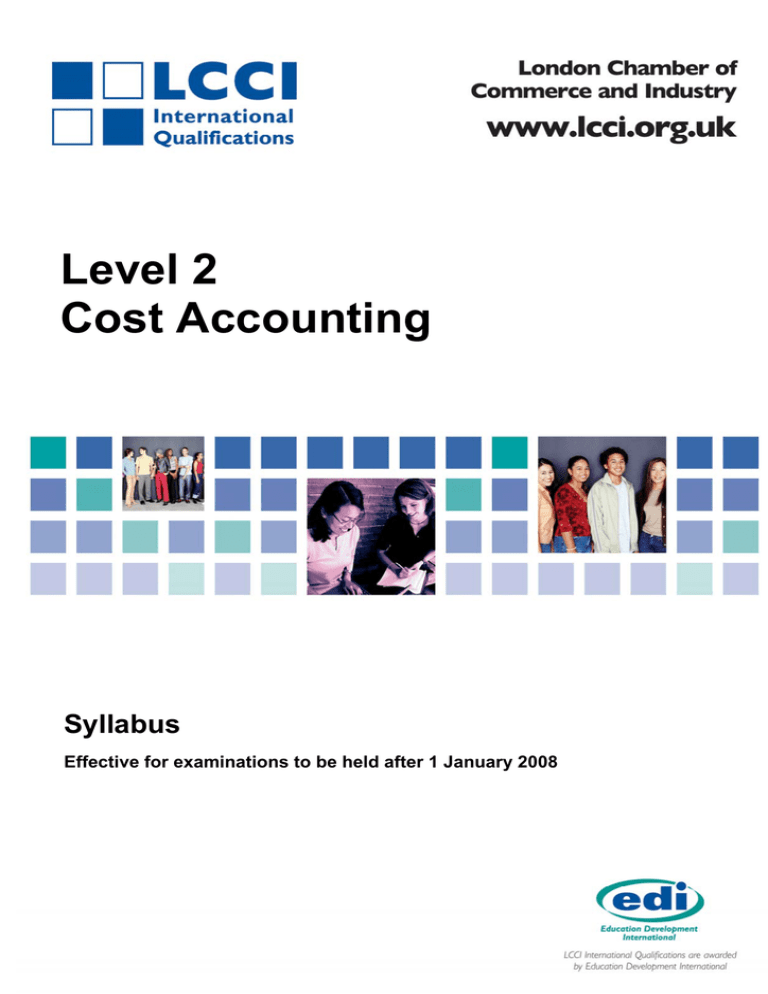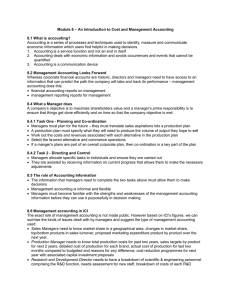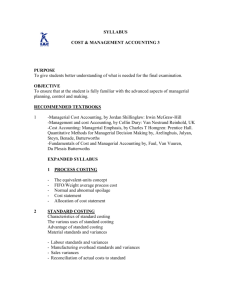
Level 2
Cost Accounting
Syllabus
Effective for examinations to be held after 1 January 2008
ASPE0483
>f0t@WJY9W2`4s3dPd#
Vision Statement
Our vision is to contribute to the achievements of learners around
the world by providing integrated assessment and learning services,
adapted to meet both local market and wider occupational needs
and delivered to international standards.
© Education Development International plc 2005-2007 Company Registration No: 3914767
All rights reserved. This publication in its entirety is the copyright of Education Development International plc.
Reproduction either in whole or in part is forbidden without written permission from Education Development International plc.
International House Siskin Parkway East Middlemarch Business Park Coventry CV3 4PE
Telephone: +44 (0) 8707 202909 Facsimile: + 44 (0) 24 7651 6566
Email: customerservice@ediplc.com
2
INTRODUCTION
Education Development International (EDI) is a leading international awarding body that was
formed through the merger of the London Chamber of Commerce and Industry Examinations
Board (LCCIEB) and a leading online assessment provider GOAL. EDI now delivers LCCI
International Qualifications (LCCI IQ) through a network of over 4000 registered centres in
more than 100 countries worldwide. Our range of business-related qualifications are trusted
and valued by employers worldwide and recognised by universities and professional bodies.
Level 2 Cost Accounting
Aims
The aims of this qualification are to enable candidates to develop:
•
a detailed understanding of how financial transaction data may be processed to provide
cost accounting data
•
a basic understanding of how cost accounting information can be used for the purposes
of planning and control within business organisations
•
the ability to apply this understanding of planning and control in a variety of business
settings
Assessment Objectives
The examination will assess the candidate’s ability to:
•
demonstrate detailed knowledge and understanding of methods of cost accounting data
processing
•
demonstrate knowledge and understanding of planning and control principles,
techniques and processes
•
apply the knowledge and understanding of planning and control in a variety of business
settings
Target Audience and Candidate Progression
This qualification is suitable for candidates who are working, or are preparing to work, in an
accounting environment at a level that requires a moderate level of cost accounting
knowledge and skill, as well as a basic understanding of cost accounting principles and
practice. Candidates attempting this qualification should have the knowledge and skills
equivalent to the LCCI IQ Level 1 Book-keeping qualification in order to understand the
relationships between financial accounting and cost accounting, and basic accounting terms.
Candidates who achieve Level 2 Cost Accounting may progress to the Cost Accounting
and/or Management Accounting LCCI IQ Level 3 qualifications.
3
Level of English Required
Candidates should have a standard of English equivalent to LCCI IQ Level 1 English for
Business.
Syllabus Topics
1.
Basic terminology and cost classification
2.
Costing for materials
3.
Costing for labour
4.
Costing for overheads
5.
Costing methods
6.
Marginal costing
7.
Budgetary planning and control
8.
Standard costing and variances
9.
Accounting systems
Examination Format
The time allowance for the examination is 2.5 hours. The paper will consist of 5
compulsory questions. All questions will carry equal marks.
At least 2 of the following syllabus topics will appear on each examination:
2. Costing for materials
3. Costing for labour
4. Costing for overhead
Guided Learning Hours
EDI recommends that 140-160 Guided Learning Hours (GLHs) is a suitable course duration
for an ‘average’ candidate at this level. This figure includes direct contact hours as well as
other time when candidates’ work is being supervised by teachers. Ultimately, however, it is
the responsibility of training centres to determine the appropriate course duration based on
their candidates’ ability and level of existing knowledge. EDI experience indicates that the
number of GLHs can vary significantly from one training centre to another.
4
Candidate Performance Measurement
Pass Mark Information
Pass
Credit
Distinction
50%
60%
75%
Mark Allocation
A positive marking approach is used; although candidates will be penalised for initial
calculation errors, they will gain marks for consequential ‘own figures’ as long as the correct
use of principles has been demonstrated.
Recommended Reading and Support Material
Title
Author
Publisher
ISBN Code
How to Pass Cost Accounting
Second and Third Levels
D Skidmore
LCCIEB
1 86247 000 6
How to Pass Cost Accounting
Second and Third Levels
Teachers’ Guide
D Skidmore
LCCIEB
1 86247 015 4
Support Material
A specimen paper with answers is available from the LCCI IQ website.
5
Syllabus Topic
Items Covered
1
Candidates must be able to:
Basic terminology and cost
classification
1.1
Explain the meaning and purpose of
cost accounting
1.2
Explain the relationship between
financial accounting, cost accounting,
and management accounting
1.3
Classify costs by element and function
for different types of organisations
1.4
Distinguish between direct and indirect
costs
1.5
Explain cost centres and cost units
1.6
Select suitable cost units for given
industries and organisations
1.7
Explain the principles of cost code
design
1.8
Construct a simple cost code for a given
situation
1.9
Classify costs by behaviour, i.e. into
variable, semi-variable, stepped and
fixed categories
1.10 Identify the behavioural classification for
a cost from a given total cost-volume
graph or unit cost-volume graph
1.11 Sketch a total cost-volume graph or unit
cost-volume graph to represent a cost
from given information
2
Costing for materials
Candidates must be able to:
2.1
Calculate material requirements, making
allowance for sales, product stock
changes and material stock changes
2.2
Explain the purpose of the various
documents used in the process of
ordering, receiving, storing and issuing
materials
2.3
Explain the meaning of perpetual
inventory and continuous stocktaking
6
3
4
Costing for labour
Costing for overheads
2.4
Suggest reasons for discrepancies
between the inventory record and
physical stock
2.5
Prepare records of stock movement in
quantity and value terms
2.6
Price issues of stock using FIFO, LIFO
and weighted average methods
2.7
Contrast the effect of alternative pricing
methods on cost of sales, stock values
and reported profits
2.8
Make accounting entries for materials in
an integrated accounting system
Candidates must be able to:
3.1
Identify the costs to a business as a
result of employing people and the costs
relating to labour turnover
3.2
Describe and contrast methods of
remuneration
3.3
Apply various remuneration methods
and demonstrate the effect of each on
unit costs
3.4
Calculate total gross earnings and
analyse, by cost centre, into
direct/indirect costs including the
treatment of overtime premium, shift
allowance and idle time
3.5
Make accounting entries for
direct/indirect labour in an integrated
accounting system
Candidates must be able to:
4.1
Identify sources of overhead cost
4.2
Explain the purpose of overhead
allocation, apportionment and
absorption
4.3
Allocate production overheads to
production and service cost centres
4.4
Allocate production overheads to
production and service cost centres
7
4.5
Re-apportion production overheads from
service cost centres to production cost
centres using repeated distribution
method
4.6
Outline the reasons for using
predetermined absorption rates
4.7
Calculate and apply production
overhead absorption rates based upon
direct material cost, direct labour cost,
direct labour hours, machine hours and
units of output
4.8
Explain the factors influencing the
choice of production overhead
absorption method
4.9
Calculate a rate to absorb
administration, selling and distribution
overheads
4.10 Calculate and account for any under or
over-absorption of production overhead
4.11 Make accounting entries for overhead in
an integrated accounting system
5
Costing methods
Candidates must be able to:
5.1
Distinguish between job, batch and
process costing
5.2
Prepare a job cost and calculate a
selling price
5.3
Prepare a batch cost
5.4
Prepare a process account or process
statement
5.5
Show the treatment of normal losses
and scrap values
5.6
Use equivalent units to place a value
upon closing work-in-progress in a
single process (questions will not
contain opening work-in-progress)
5.7
Explain and account for by-products
5.8
Explain and account for joint products,
apportioning joint costs on the basis of
physical units
8
6
7
Marginal costing
Budgetary planning and control
Candidates must be able to:
6.1
Explain marginal costing as a technique
6.2
Explain the terminology of marginal
costing – variable cost, fixed cost,
contribution, break-even point,
contribution/sales (CS) ratio
6.3
Calculate contribution per unit, total
contribution and contribution/sales ratio
6.4
Prepare profit statements on either a
marginal cost or an absorption cost
basis
6.5
State the assumptions upon which costvolume-profit (CVP) analysis is based
6.6
Calculate the break-even sales revenue
and sales units for a single product
6.7
Calculate required sales for a given
profit
Candidates must be able to:
7.1
Explain the difference between a
forecast and a budget
7.2
Explain budgetary planning and control
7.3
Explain the benefits expected to accrue
from the use of budgets
7.4
Explain the meaning and importance of
the principal budget factor
7.5
Prepare the following budgets:
• Sales
• Production
• Materials usage
• Materials purchases
• Machine utilisation
• Direct labour
7.6
Prepare a budgeted profit and loss
statement
7.7
Prepare a cash budget and explain its
importance
9
8
9
Standard costing and variances
Accounting systems
Candidates must be able to:
8.1
Explain the meaning of standard cost,
standard costing and variance
8.2
Distinguish between an ideal standard
and an attainable standard
8.3
Prepare a standard production cost for a
product
8.4
Calculate a direct material total variance
and analyse this total into price and
usage variances
8.5
Calculate a direct labour total variance
and analyse this total into rate and
efficiency variances
8.6
Interpret prime cost variances
8.7
Make accounting entries for standard
prime costs and prime cost variances in
an integrated accounting system
Candidates must be able to:
9.1
Describe the nature and function of an
integrated accounting system
9.2
Describe the function and operation of
control accounts, particularly for material
stocks, work-in-progress stocks, finished
stocks and production overheads
9.3
Make all entries in the integrated ledger
to record the transactions of a period
10
© Education Development International plc 2005-2007 Company Registration No: 3914767
All rights reserved. This publication in its entirety is the copyright of Education Development International plc.
Reproduction either in whole or in part is forbidden without written permission from Education Development International plc.
International House Siskin Parkway East Middlemarch Business Park Coventry CV3 4PE
Telephone: +44 (0) 8707 202909 Facsimile: + 44 (0) 24 7651 6566
Email: customerservice@ediplc.com
11




